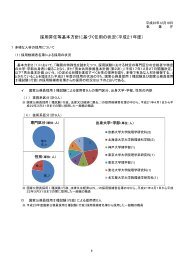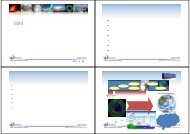Chapter 5 Measurement of Atmospheric Pressure
Chapter 5 Measurement of Atmospheric Pressure
Chapter 5 Measurement of Atmospheric Pressure
Create successful ePaper yourself
Turn your PDF publications into a flip-book with our unique Google optimized e-Paper software.
while the barometer is set on the hanger plate. This allows verticality checks at any time.A mica plate is wound inside the brass cylinder to prevent the direct contact betweenbrass and the wash-leather bag. The plate serves as a heat insulator as well as preventscontamination, discoloration, and wear.(3) Handling precautions for mercuryHigh-purity distilled and refined mercury is used in mercury barometers. When the mercurysurface oxidizes, the interface between the surface and the ivory pointer becomes unclear.Heavily contaminated mercury surface requires cleaning. Since mercury is a toxic substance,it is necessary to pay attention to the following when handling mercury.1) A container <strong>of</strong> mercury must be sealed tightly to prevent leakage and breakage. Do notput mercury into any metal containers as mercury reacts and amalgamates almost allmetals except for iron.2) The floor <strong>of</strong> the room where mercury is stored or used in large amounts should be shieldedand laid with an impervious covering. It must not be stored together with otherchemicals, especially with ammonia or acetylene.3) Mercury has a relatively low boiling point <strong>of</strong> 357 °C, and produces dangerous poisonousgas if on fire. It must not be stored close to a heat source.4) Check the mercury handling room and personnel periodically to make sure that theamount <strong>of</strong> mercury does not exceed the dangerous limit. (The environmental regulationon water contamination affecting personal health limits the total amount <strong>of</strong> mercury to0.0005 mg/l.)(4) Correction <strong>of</strong> barometer readingsThe mercury barometer’s reading should be corrected to the one and the standard condition.Standard condition is defined as a temperature <strong>of</strong> 0 °C, where the density <strong>of</strong> mercury is13.5951 g/cm 3 and a gravity acceleration <strong>of</strong> 980.665 cm/s 2 .During actual observation, the reading should be corrected for the index error,temperature correction, and gravity acceleration as follows:(a) Corrections on index errorIndividual mercury barometers include index errors (difference between the valueindicated by an individual instrument and that <strong>of</strong> the standard). The index error is foundby comparison with the standard, and the value is stated on a "comparison certificate".(b) Corrections for temperatureThe temperature correction means to correct a barometric reading, obtained at a certaintemperature, to a value when mercury and graduation temperatures are 0 °C. Thetemperature <strong>of</strong> the attached thermometer is used for this purpose.The height <strong>of</strong> the mercury column varies with temperature, even the atmosphericpressure is unchanged. The graduation <strong>of</strong> the barometer is engraved so that the correctpressure is indicated when temperature is 0 °C. In a case that when temperature is above0 °C, the graduation expands and the measured value will be smaller than the true value.This effect <strong>of</strong> temperature must be corrected from these two aspects collectively.3






![関東地方の「紅葉の見ごろ予想」[PDF形式:250KB] - 気象庁](https://img.yumpu.com/47747063/1/184x260/pdf250kb-.jpg?quality=85)

![雨に関する各市町村の50年に一度の値一覧[PDF形式:417KB] - 気象庁](https://img.yumpu.com/47450161/1/190x134/50pdf417kb-.jpg?quality=85)
![1か月予報[九州北部地方]解説資料](https://img.yumpu.com/47153516/1/184x260/1.jpg?quality=85)
![職員募集案内パンフレット[PDF形式:約9MB] - 気象庁](https://img.yumpu.com/45714300/1/184x260/pdf9mb-.jpg?quality=85)


![ダウンロードファイル[PDF形式: 約15MB] - 気象庁](https://img.yumpu.com/43657928/1/190x135/pdf-15mb-.jpg?quality=85)


